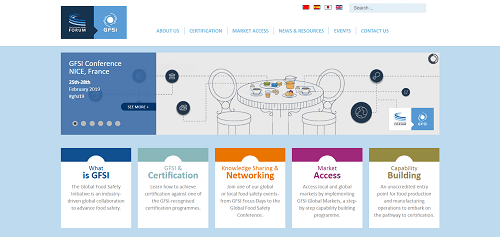Food safety compliance is a key priority for any food manufacturer, and today’s consumer landscape continues to evolve with new requirements. Apart from core safety compliance, there exists additional, and very crucial, product requirements for claims of sustainability, organic, and allergy-free, as well as many others based on defined target markets. Ostensibly, selecting the right set of requirements and the best auditing and compliance partner to work with can be a difficult choice for manufacturers of any size.
In response to these very challenges, the Global Food Safety Initiative (GFSI) was created in 2002 as a non-profit to provide guidance in the form of GFSI benchmark standards. The GFSI is managed by the Consumer Goods Forum (CGF), a global industry network comprised of senior management from over 400 retailers, manufacturers, and organizations from all areas of the manufacturing supply chains, spanning a staggering 70 countries. Of the food safety professionals who have utilized the GFSI benchmarks, 72% say the changes have helped to enhance food safety practices at their facilities, a figure which is a powerful testament to the widespread standards network that the initiative has created.
The standards outlined by the GFSI provide a flexible but clear framework for the compliance requirements a manufacturer should select from and incorporate into their existing and unique safety and quality policies. To ensure that you have a broad picture of these requirements, how they were initially selected, and how best to implement them, let’s explore this topic in detail.
In today’s guide we’ll discuss:

The GFSI Benchmark Standards are captured in a regularly updated guidance document available through on the GFSI website. (The latest version as of this writing is 7.1, released Apr 2017). These standards are intended to capture the best practices among global industry entities and governments. The requirements themselves cover three major areas:
The guiding principles are consistent for the overall food industry, but specific requirements differ among each food supply chain sector. In order for food manufacturers to get the right guidance, it is very important to select the global food safety standard(s) that correspond directly to the operation.

For those companies still reviewing their food safety standard strategies, it is important to consider whether GFSI will be an important asset to their operations. By reviewing customer requirements, feedback, market competitiveness, and operational needs, it is possible to have a clearer picture of what the appropriate standardization scope should look like. The development of a food safety and quality program is a long-term process requiring a large investment of money, time and energy. If the operation exists in a niche market or segment that does not require or recognize GFSI, it may make sense to focus on the more certifications that are unique to the specific market. For operations that are part of a broader international supply chain, the need for guidance from an organization like GFSI becomes more crucial.
In recent years, GFSI has gained wide adoption from major global retailers such a Carrefour, Tesco, Walmart, Amazon, and Kroger, among many others, by facilitating simplification in requirements within their very broad supply chains. This means that, if an operation is part of a supply chain for one or more of these retailers who recognize GFSI, it’s likely important that they hold the same certifications. Some food manufacturers may have complex quality standards defined for their markets and could face challenges in aligning their safety and quality standards to broadly defined guidelines. Because of these complexities, it is very important to recognize that each of the major recognized food safety standards within the GFSI certification program is, in fact, interrelated.

As of today, there are eleven major recognized food safety management standards that have been certified by GFSI as meeting their benchmarking requirements. Each set of standards has a unique focus and scope, and though there could be overlap for some requirements, there are also important differences. Initiatives and bodies that hold similar standards include:
Each of these standards contains sub-categories of requirements falling under specific review by GFSI as they are updated. The current complete list is available on the GFSI website; it should be noted that, among them, these standards cover all sectors of the food supply chain sector. What makes GFSI different is that it helps organizations narrow down the safety standards most relevant to their operation by providing categories for their particular scope: such as “farming of animals” or “processing of plant perishable products.” There are fifteen scopes outlined within their documentation and each food manufacturer should select the scope(s) in which they currently operate or aim to operate.

As mentioned previously, some requirements can vary based on the specific scope of operation (food manufacturers, food packaging and material producers, food storage and distribution, or food brokers). After narrowing down the list of appropriate standards an operation can begin the selection process by reviewing the detailed requirements for each.
Once the official list is then determined, the next most important factor to consider the specificity of the requirements. Standards can vary from being highly specific, while others provide broader definitions, allowing the organization to define some of the details. For instance, if the organization already has a fully developed set of processes, it may make sense to seek broader definitions, as they allow existing systems to be more easily fine-tuned. Those with newer operations may benefit from simply copying detailed requirements.
Two of the most widely adopted standards are the Safe Quality Food (SQF) Standard and the British Retail Consortium (BRC) Food Standard. These standards each provide a wide and comprehensive list of requirements that can satisfy demands across a broad customer portfolio. By looking at a full picture of an organization, including key operations, strengths, and weaknesses, it can then select the right certification partner and help define a clear path forward.
There are also certain food safety standards that provide “add-on” compliance guidelines for specific requirements, such as gluten-free or organic, that can be bundled into a single compliance package to meet all customers’ needs. Another consideration is the regional availability of auditors based on the local acceptance of those standards. Because the adoption of standards can vary by segment and/or region, these must be cross-checked to guarantee that there are local and available auditors who can align to all compliance needs. This simple step avoids potential costly and time-consuming travel or scheduling delays.

The moment a set of standards and a certification body has been selected, it is important to determine the appropriate auditing schedule based on the requirements set within. Certification bodies can provide some guidance, but it is up to the organization to determine the structure most appropriate for their operations. Factors such as facility size, number of employees, and type of manufacturing can all have an impact on the audit schedule. Most certifications look at a three-year cycle of compliance and require annual audits. The types of audits could vary over this period (such as with FSSC) or be consistent each year.
Once an audit is conducted, the follow-up for corrective actions will be dictated largely by the certification body’s program. While the GFSI standards define the requirements, they do not specify details for compliance. It is therefore very important for the organization to familiarize itself with the specific compliance plan of the auditing partner. Follow up for corrective actions could vary from a matter of weeks up to the time of the next audit and could also include onsite visits to verify compliance. Some standards, such as BRC and SQF, also require a six-month audit schedule for follow-up until the corrective action(s) are considered closed.
All of these considerations can have a major impact on the costs associated with the initial certification and ongoing maintenance of compliance as they relate to the chosen food safety standard. By including them in the planning process, the operation can prevent surprises and build confidence in its internal food safety and quality programs.

For those smaller food manufacturers seeking to reach compliance with GFSI recognized standards, the GFSI has created a Global Markets program. It can seem like a daunting undertaking to initiate programs that adhere to global safety and quality standards, and while this program does not, in and of itself, provide any certification, it is a reasonable way for companies to create a path toward eventually working with a safety standard compliance auditor in the future.
Another important, related certification is the ISO 22000 standard. The overall ISO 22000 is recognized worldwide and relevant to any sector of the food supply chain. It is also part of the FSSC 22000 standard recognized by GFSI within the definitions for the food safety management portion. Even though the overall ISO 22000 standard is not directly recognized by GFSI, it provides a broad, comprehensive framework that could be very valuable if a food manufacturing business does not require GFSI or if it has experienced difficulty fitting the scope of other recognized standards into the operation.
One final external standard to consider is the Food Safety Modernization Act (FSMA), which is important for any company operating within or importing to the US. But, similarities aside, the GFSI benchmark guidelines do not directly meet all of the requirements laid out in the FSMA. For this reason, it is important to consult the analyses done by each GFSI standard, which compares their standards versus the guidelines of FSMA and will highlight any additional work that may be necessary to reach full FSMA compliance.
As requirements continue to develop in the food industry, it is key for food manufacturers of all sizes and operations to align themselves with standards – from sanitary welding standards to surface finish standards – that provide broad compliance for the needs of their customer base and supply chains. The GFSI has taken major steps in facilitating these transitions and continues to provide ongoing technical working groups, benchmarking, and facilitated conferences to share knowledge and encourage unified approaches.
For more information on the specifics surrounding the GFSI benchmarking standards and what they mean for your food manufacturing business, visit the following resources:
Our sales engineers are experts in automatic asset tracking, tagging and identification,a nd can answer all your questions. Get in touch now.
Lets Talk ›